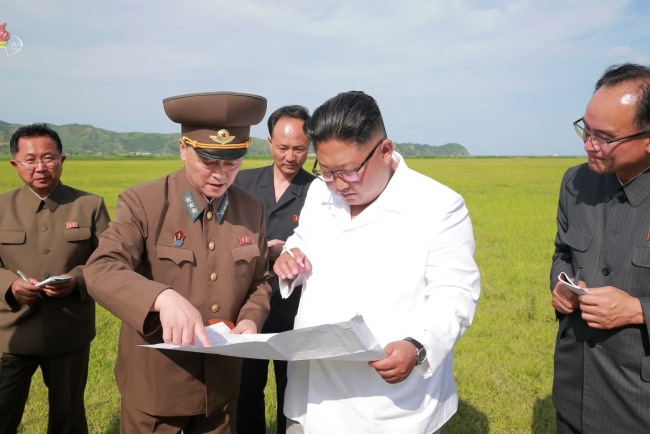North Korea’s annual real gross domestic product in 2017 retreated 3.5 percent on-year, marking the sharpest fall in over 20 years, as sanctions on the North appear to have taken a toll on its exports, data showed Friday.
This comes in contrast to the secluded state’s 3.9 percent on-year economic growth in 2016, according to data compiled by the Bank of Korea. The degree of decline is the steepest since 1997, when the real GDP decreased by 6.5 percent on-year.
The central bank cited a lack of energy sources and raw materials in North Korea last year, as well as a decline in agricultural and hydropower production due to droughts including one considered the worst since 2001.
 |
(KCNA-Yonhap) |
Agriculture, forestry and fishing industries combined fell 1.3 percent on-year, while mining and manufacturing industries slid 11 percent and 6.9 percent, respectively. All the aforementioned industries saw a downturn from a rise in 2016.
North Korea’s exports, excluding those to South Korea, sank 37.2 percent on-year to $1.8 billion in 2017. Sharp declines in exports of mineral products and textile products, by 55.7 percent and 22.2 percent, respectively, contributed to the decline. The North’s trade volume reached $5.6 billion, down 15 percent on-year.
A BOK official said the North’s export volume will continue to decline this year, citing an 87 percent on-year drop in its exports to China from January until May this year. China accounted for some 95 percent of North Korea’s trade in 2017, the official added.
This came in line with sanctions imposed on North Korea last year, including a ban on coal, iron and marine product exports following a resolution by the United Nations Security Council in August 2017.
Meanwhile, North Korea’s annual nominal gross national income in 2017 came to 36.6 trillion won ($32.2 billion), or one-47th that of South Korea, up 0.7 percent on-year. The North’s GNI per capita stood at 1.5 million won, or 4.4 percent of the South.
The BOK added in the press release the figures are not directly comparable with global macroeconomic indicators, as it used South Korea’s price data and value added ratio for the estimate. The central bank has released North Korea’s annual macroeconomic data since 1991.
By Son Ji-hyoung
(
consnow@heraldcorp.com)








![[Today’s K-pop] Blackpink’s Jennie, Lisa invited to Coachella as solo acts](http://res.heraldm.com/phpwas/restmb_idxmake.php?idx=644&simg=/content/image/2024/11/21/20241121050099_0.jpg)